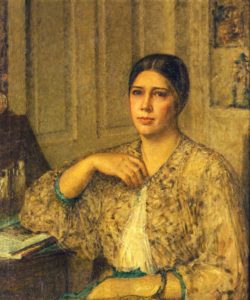Helen Maria Turner
New Orleans painter Helen Maria Turner was best known for her paintings of people in their own homes and women in gardens.

Courtesy of Ogden Museum of Southern Art
Portrait of a Lady. Turner, Helen Maria (Artist)
Born in Louisville, Kentucky, on November 13, 1858, Helen Maria Turner died in New Orleans in 1958, just ten months before her one-hundredth birthday. Through her long career as an artist, she moved from realism and impressionism, using media as varied as pastels, watercolors and oils to create portraits, landscapes, still lifes, and miniatures. She was best known, however, for her paintings of people in their own homes and women in gardens.
Though not a native Louisianian, Turner lived the bulk of her life in the state. Most of her childhood was spent in Alexandria, Louisiana, although she spent a good amount of time in New Orleans, where her family was well connected. Turner’s mother was the daughter of a well-known doctor in New Orleans and the granddaughter of John Pintard, principal founder of the New York Historical Society and the American Academy of Fine Arts. The family’s fortunes changed during the Civil War. Her father suffered the loss of his coal business, and her mother died after a long illness. When her father died in 1871, Turner became a thirteen-year-old orphan. Her uncle, a doctor, moved her and her siblings to New Orleans.
Turner did not begin to paint until she was twenty-two years old, when she started to create portraits and bayou scenes. She began her formal study of art at Tulane University in New Orleans at free drawing classes, then continued her studies from 1886 to 1893 with the Artists’ Association of New Orleans. Andres Molinary and Bror Anders Wikstrom were important mentors and influences.
The death of her uncle in 1890 required Turner to support herself. She began to teach, first at St. Mary’s Institute, a girls’ school in Dallas, Texas, in 1893. Realizing, in her own words, “what a farce it was for one without education to be teaching others,” she left two years later and moved to New York City, where she began studying with Douglas Volk at the Art Students’ League of New York City, then followed him to the Women’s Art School of Cooper Union, from which she graduated. Turner took additional courses at Teacher’s College of Columbia University in New York, where she also taught part time. Unlike most American artists caught up in the impressionism movement of Europe, Turner seemingly had little interest in studying abroad. She preferred to work with painters in her own country, although she joined William Merritt Chase’s summer class in Italy for three years. In 1902, Turner became an instructor of cast and life drawing, color, and costume drawing at the art school of the New York City YWCA, a position she held until her retirement in 1919. She was gratified to assist a “generation of working girls in learning artistic skills rather . . . than making paper flowers.”
During her New York years, Charles Curran introduced Turner to Cragsmoor, an artists’ colony located in the Shawangunk Mountains of upstate New York. It would prove to be a profound influence on her life and work. In 1906 Turner began spending her summers there, a practice she continued for the next thirty-five years until, at the age of eighty-three, travel became too difficult. Its influence can be seen in the floral backgrounds that frequently appear in her paintings, the result of the passion she developed for gardening in Cragsmoor. In 1926 she returned to New Orleans during the school year, teaching draped-model drawing at the Arts and Crafts Club of New Orleans. She moved permanently to New Orleans in 1942.
Turner’s works have been exhibited and collected widely. Beginning with exhibitions by the Artists’ Association of New Orleans, they were later displayed by the New York Water Color Club, the Pennsylvania Academy of Fine Arts in Philadelphia, the American Society of Miniature Painters at the National Academy of Design in New York City, and the Corcoran Gallery in Washington, D.C. One of the most prestigious exhibitions in which she participated was titled Six American Women, organized by the City Museum in St. Louis, Missouri. In addition to Turner, it featured Mary Cassatt, Jane Peterson, Johanna Hailman, Martha Walter, and Alice Schille.
Her awards were as numerous as her exhibitions. Turner received the Cooper Union (New York City) bronze medal; the Elling prize for landscape from the New York Woman’s Art Club; the National Arts prize from the Association of Painters and Sculptors; the Julia A. Shaw Memorial Prize from the National Academy of Design; and the John G. Agar prize from the National Association of Women Painters and Sculptors. It is interesting to note that she was only the third woman elected to full membership in the National Academy of Design, the first academician from Louisiana, and one of the first from the entire South. In 1949 the New Orleans Museum of Art honored her with a special exhibition of her work to mark her ninetieth birthday.
Public interest in her work continued throughout the 1930s, but as she grew older her eyesight limited her productivity. By 1949 she was unable to paint any longer due to cataracts. She is remembered today for her confident brushstrokes and her skillful handling of light and shadow in her depictions of women in floral environments.
